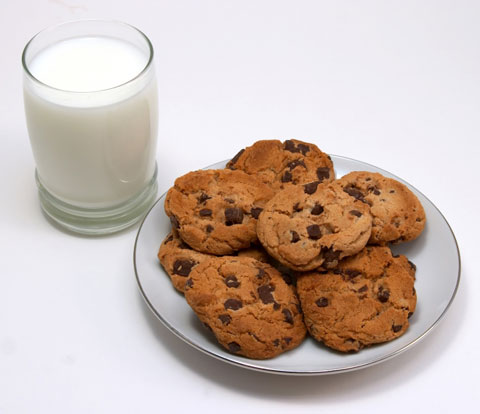The Invisible Breasts of the Free Market
Allo-Mother’s Milk discussed cultural, historical, and evolutionary perspectives of allo-mother’s milk. Here the story continues…
Right now numerous entities are developing a “milk” supply for clinical intervention. Examples of this endeavor are Prolacta and the non-profit Human Milk Bank Association of North America. One critically important application for donor milk is that it reduces the risk of necrotizing entercolitis in NICU babies. A recent meta-analysis of randomized, controlled trials revealed that premature babies that consumed commercial formula were 4 times more likely to develop this dangerous infection than premature infants that consumed donor milk (Ben et al. 2012).
These "milk" supply efforts rely on donated milk from women screened for heath and lifestyle. After donation, milk undergoes processing to make it safer (e.g. pasteurization). These processes, while important for protecting the recipient, can also neutralize some of the beneficial bioactive constituents in milk. Moreover the overhead costs and clinical applications of these milk banks and commercial entities limit the general public’s access to human milk.
And the general public is clamoring for raw, unpasteurized human breast milk.
As stated by Geraghty et al. 2011 “A first step in understanding how to share raw, unpasteurized human milk is simple: just enter key words such as “breast milk” or “human milk” into an Internet search engine along with another descriptor such as “buy, purchase, sell, want, for sale, or share.” This action produces a variety of links to donor milk banks, classified advertisements, blogs, chat rooms on social networking sites, and random posts.”
I’ll be honest, selling human breast milk -unscreened, unregulated- on the internet is terrifying to me on numerous levels. Let’s just set aside my humanist concerns about how the current economic climate induces women to upregulate milk synthesis to make ends meet, potentially compromising their own health and their baby’s health. This keeps me awake at night because of the basic deficits in our fundamental understanding of breast milk.
We don’t know what is in milk.
Yay for Terran Echegoyen-McCabe and Christina Luna!
Although we know that in general milk contains hundreds, maybe thousands, of bioactive molecules, a systematic description of everything in human milk does not exist. There are constituents that are crucial for the infant’s health and development that are not yet in commercial formulas such as immune factors, oligosaccharides, growth factor, cortisol, and beneficial bacteria. This is why people are keen to buy breast milk, and willing to go online to do so.
But in terms of buying milk from faceless strangers on the internet, we have no idea what is in that specific milk. Milk can include viruses, pathogenic bacteria, drugs, and poisonous toxins. HIV, E. coli, and meth are rare and the probability that they are the milk being traded online is slim, but its not zero. If I was at the hospital and I had a choice between Bag A and Bag B for my blood transfusion, and Bag A definitely didn’t have HIV or meth, and Bag B probably didn’t, guess which bag I'd choose. I certainly wouldn't say "Let's have my lucky quarter decide- heads, Bag A and tails, Bag B!"
And lots of potentially dangerous things in milk aren't quite so rare- such as BPA, cytomegalovirus, and over-the-counter drugs.
Moreover the value of human breast milk is by volume. The composition can not be evaluated by the consumer. Now, I expect that most people are likely providing healthy, safe milk via the internet. But just as some unscrupulous drug dealers cut cocaine with talcum powder, internet milk may be padded with cow’s milk or tap water. At least the drug dealer has someincentive to not sell weak blow. The drug dealer wants to keep customers coming back- and not to kick his ass. Those constraints don’t apply to people selling human milk on the internet. The benefit of cheating is very high, the risk of getting caught is very low, and the consequences if caught are NOTHING.
We don’t know how or why milk constituents vary.
Studies have shown that concentrations of constituents in milk vary across lactation within mother or among mothers at any given time, but we don’t entirely know how much or why (Hinde & Milligan 2011). Sure, we know that colostrum is different than mature milk, but that’s a simple dichotomy. This isn’t the bulk candy aisle where mixing and matching gummy worms and chocolate covered pretzels provides the perfect synthesis of savory and sweet.
Across infancy there are critical windows of metabolomic, neurobiological, skeletal, and physiological development. Sometimes there are do-overs and catch up, but sometimes there aren't. The functional development of the mammary occurs during pregnancy when a woman’s placenta and fetus can hormonally signal to her mammary gland. For this reason scientists hypothesize that the milk a mother synthesizes is specific to her infant precisely at that time, linked to that infant’s developmental trajectory and her own condition. Although there may be benefits to allo-mother's milk from an evolutionary perspective, when observed in other mammals allo-mother's milk supplements mother's milk, its not usually a replacement.
We don’t know what all constituents do in the baby.
That’s right, I said it.
Lovely Adelaide
We. Don’t. Know.
There are relatively few studies that look at the consequences for the infant as a result of variation in the concentration of milk constituents and milk volume among mothers. Fortunately, this area of research is expanding due to new assay methods and renewed intellectual interest in inter-individual differences. Milk is the new British Empire- the sun never sets on lactation science. Dairy milk is a leading global industry and unlocking the fundamentals of mammary gland biology is critical for cancer research. If we had all the answers to milk- the sum total of what it is and what it does- that would be fantastic. But research takes money and time, especially when studying incredibly complex humans who develop slowly.
And in the meantime, I can swing over to Only the Breast, browse the profiles of women and photos of their robust babies, and buy "liquid gold" for $2/oz.
So what is the solution?
Obviously we have to tip the scales of supply and demand.
Goal #1: Reduce Demand for “Grey” Market Human Breast Milk
RISK AWARENESS Solution: Effectively communicate the risks and dangers of purchasing unscreened human breast milk from strangers. One way to do that would be to… oh… I don’t know… hows about you forward this blog post?
IMPROVED FORMULA Solution: Parents who want to feed their baby breast milk, but for whatever reason can't, are buying internet milk because they don’t want to use formula. If a more representative formula were available (cost effectively), its likely that fewer parents would take the risk of internet breast milk. Commercial infant formulas need to better reflect the complex biofluid that is human milk. Advantageously, many companies are interested in doing just that. Commercial formula R&D teams are actively translating new data on mother’s milk into food science.
Goal #2: Increase the Supply of Breast Milk
MORE HUMAN MILK Solution: Expand the current national network of milk banks, donor programs, and private industry similar to the management of our national blood supply. (American Red Cross… I am looking in your direction). Just as many hands make light work, many boobs produce substantial volumes of life-saving donor milk, at low per individual cost. This would generate a larger supply of donor milk, increase screening of donated milk, and standardize “best practices” for collection and storage. Such a plan would have to guard against potential problems of the commercialization of human fluids (very tricky). It would also require the improvement of processing techniques so as to retain the bioactivity of milk constituents. Most importantly, the products of these efforts can not be restricted exclusively to clinical settings like the NICU. We must find a way to make them safely and economically available to the general public.
The solutions outlined above are contingent on fundamental milk science research. We can’t communicate the specific risks without broadly surveying milk composition across women. Similarly, infant formula can’t be improved without a better understanding of how bioactive constituents in milk affect babies. Lastly, we need to optimize milk processing techniques to maximize safety without neutralizing important bioactive constituents. Research of this magnitude requires substantial investment in the form of research grants, but the benefits to human health and nutrition are substantial.
The US Department of Health and Human Services oversees the National Institutes of Health, the leading funders of human health research in the US. Currently, Strategic Initiatives of the DHHS include the goals to:
-Promote Early Childhood Health and Development
-Implement a 21st Century Food Safety System
-Accelerate the Process of Scientific Discovery To Improve Patient Care
Breast milk, and the online trading of it, has implications for all of these initiatives. If these topics matter to you and you think funding research on mother's milk is important, I encourage you to contact DHHS Secretary Sebelius and/or your senators and representatives in Congress.
and seriously, if you didn't read Part I: Allo-Mother's Milk, you really should because it has hypotheses presented in playlist form.
and seriously, if you didn't read Part I: Allo-Mother's Milk, you really should because it has hypotheses presented in playlist form.
Citations
Ben et al. 2012. The Benefits of Expressed Maternal Milk and Donor Breast Milk for Preventing Necrotizing Enterocolitis in Preterm Infants: Systematic Review and Meta-Analysis. J Nutrition Disorder Ther 2:2 doi.org/10.4172/jndt.1000110
Geraghty, Heier, & Rasmussen. 2011. Got milk? Sharing human milk via the Internet. Public Health Rep. 126:161-4.
Hinde & Milligan. 2011. Primate milk: proximate mechanisms and ultimate perspectives. Evol Anthropol. 20:9-23
And naturally just as I finished writing this post I discovered a kickass article over at Slate.






Comments
Post a Comment